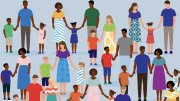President Drew Faust on April 24 appointed a University steering committee to explore improvements to Harvard’s Cambridge campus, with the aim of making better use of existing spaces to foster faculty-student interaction, social life, and artistic and cultural performances. The goal is to effect improvements in the areas near Harvard Yard, even as planning proceeds for the long-term development of the academic facilities in Allston. (For the news release on the steering committee, and its members, see www.news.harvard.edu/gazette/2008/05.01/99-openspaces.html.)
Sites that might be improved include the front and rear Holyoke Center plazas; the Science Center plaza; the new quadrangle framed by the Music Building, LISE, and McKay; the south side of the Malkin Athletic Center (below); and the courtyard formed by the Bauer, Fairchild, and Converse laboratories.

The front Holyoke Center plaza

The rear Holyoke Center plaza

The Science Center plaza

The south side of the Malkin Athletic Center
The task force co-chairs are Lizabeth Cohen, Jones professor of American studies, whose scholarship and teaching are deeply involved with American urban design and physical planning (see her home page and c.v. at www.courses.fas.harvard.edu/~history/facultyPage.cgi?id=9), and Mohsen Mostafavi, dean of the Graduate School of Design, who is professor of architecture (see “A New Dean Designs without Borders,” November-December 2007, page 70).
The steering committee will work with the University Planning Office to identify sites capable of being improved physically and put to new programmatic uses. Among the spaces that come to mind are the plazas in front of the Science Center and those to the front and rear of Holyoke Center; there is also extensive space south of Malkin Athletic Center, facing Kirkland, Eliot, and Winthrop Houses.
The initiative will also complement the Faculty of Arts and Sciences’ current planning for wholesale renovation of the undergraduate residential houses during the next decade or so (see "What Makes (and Remakes) a House"); that effort includes evaluation of what new kinds of uses and spaces should be accommodated within the residences, and what should be shared among them. Faust has also commissioned a task force on the arts at Harvard, scheduled to report this autumn (see “Approaching the Arts Anew,” January-February, page 51); its recommendations could obviously contribute to fresh thinking about enhancing spaces for performance uses.
In her charge to the committee, Faust wrote, “Our goal is to provide spaces that will draw people together for work or pleasure in a spontaneous and informal way.” She cited a desire to create “visible, attractive, and inviting campus ‘focal points’ that will improve our Cambridge campus and create a sense of place that is distinctly Harvard’s, yet open to the city and surrounding communities,” and to recommend programs complementary to the spaces, resulting in “gathering places that are open and inviting to everyone, so that undergraduates, graduate students, faculty, staff, alumni, and visitors see them as appealing spaces to meet, talk, sit, read, work, reflect, or rest.” (Forward suggestions to commonspaces@harvard.edu.)
The committee’s interim recommendations are expected by this winter, with detailed feasibility studies (prepared by the planning office) completed by the fall of 2009. If that timing holds, the recommendations could be incorporated into the goals for a forthcoming University capital campaign, expected to take shape by the end of the decade.








